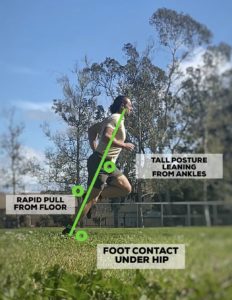
In an effort to continue developing a clearer understanding of what it means to run in better congruence with nature, we must start with a seemingly obvious detail about the context in which running occurs. There is one force acting upon us all at all times. That force, of course, is gravity. While this isn’t news to you, it’s worth mentioning because (like the fish doesn’t know what water is) our perception can lose sight of an environment that is ever present.
Gravity is the driving force behind the movement we call running. A standing human body, for example, is a source of potential energy. It quickly becomes kinetic energy when the bodyweight is displaced (or shifted) from being stacked over its base of support. In simpler terms, leaning your hips/shoulder in front of your feet when standing results in movement. This movement is called falling. What’s more impressive than the fact that this displacement created movement for you is the fact that this movement required almost no muscular effort.

Running is an act of falling. Running is not the result of profound muscular effort.
It’s worth mentioning that gravity is both free and ever present. The first principle we derive from Dr. Romanov’s findings is that in order to run in congruence with nature we must utilize our falling bodyweight as the mode of creating movement, not muscular effort. This is counter to a perceived muscular effort and common fault of running mechanics known as “pushing off”. Once the bodyweight is in front of the feet (base) of support, there is no way for the body to “push off” despite what your mind tells you or it feels like.
Since falling is the mechanism for running, you’re correct in assuming that the angle of the fall is related to the speed of the running effort. Want to run fast? You’ll need a courageous forward lean (from the ankles, not the waist) to achieve the falling position required for sprinting, for example. To improve your running, I ask that you first consider that you will move by falling forward rather than applying force into the ground. A side benefit of this first principle is that you can run with less effort than before.
In the coming two more sections we’ll address the pulling action that allows us to maintain a controlled fall and lastly the universal pose we must cyclically replicate to meet a standard of running that is congruent with nature.
Logan Gelbrich
@functionalcoach
3/27/20 WOD
Progressive Volume Work:
Complete 5 rounds for quality:
15 Hollow Rocks
20 Push Ups
25 Squats
Progressive Tempo Run
Run 11 Minutes Out
Return with a Negative Split (<11 Minutes)

